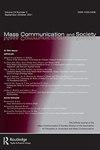Humor in Satirical News Headlines: Analyzing Humor Form and Content, and Their Relations with Audience Engagement
IF 2.7
2区 文学
Q1 COMMUNICATION
引用次数: 2
Abstract
ABSTRACT Satirical news presents a critique of current affairs through humor. Previous research suggests that satirical news can have different humor forms (e.g. linguistic strategies) and humor contents (e.g. news topics, targets), and that such differences in humor characteristics can influence audience effects of satirical news. This paper extends this research by analyzing these relationships across different types of outlets in a content analysis (Study 1) and audience engagement analysis (Study 2). In Study 1, we compared humor forms and contents of satirical news headlines posted on Facebook (N = 5,775) between outlets from different countries (United States and the Netherlands) with different political leanings (liberal and conservative). Findings showed that the coded humor forms reasonably consistently characterized satirical news across outlet types, while humor contents did not. In Study 2, we examined associations of the humor characteristics with the number of likes and comments the Facebook posts received. Results were often outlet-specific, especially in case of the coded humor contents. This paper thus reveals that when satirical news’ audience effects differ by humor characteristics, this may be attributed less to differences in humor form, and more to differences in humor content.讽刺新闻标题中的幽默:分析幽默的形式、内容及其与受众参与的关系
讽刺新闻以幽默的方式对时事进行批判。以往的研究表明,讽刺新闻可以有不同的幽默形式(如语言策略)和幽默内容(如新闻主题、对象),这些幽默特征的差异会影响讽刺新闻的受众效果。本文通过在内容分析(研究1)和受众参与分析(研究2)中分析不同类型的网点之间的这些关系来扩展本研究。在研究1中,我们比较了来自不同政治倾向(自由主义和保守主义)的不同国家(美国和荷兰)的网点在Facebook (N = 5,775)上发布的讽刺新闻标题的幽默形式和内容。研究结果表明,不同媒体类型的讽刺新闻在编码幽默形式上具有一定的一致性,而在幽默内容上则不具有一致性。在研究2中,我们研究了幽默特征与Facebook帖子收到的喜欢和评论数量之间的关系。结果往往是特定的出口,特别是在编码幽默内容的情况下。因此,本文揭示了讽刺新闻的受众效果因幽默特征而异,其原因与其说是幽默形式的差异,不如说是幽默内容的差异。
本文章由计算机程序翻译,如有差异,请以英文原文为准。
求助全文
约1分钟内获得全文
求助全文
来源期刊

Mass Communication and Society
COMMUNICATION-
CiteScore
6.90
自引率
3.30%
发文量
58
期刊介绍:
Mass Communication and Society" mission is to publish articles from a wide variety of perspectives and approaches that advance mass communication theory, especially at the societal or macrosocial level. It draws heavily from many other disciplines, including sociology, psychology, anthropology, philosophy, law, and history. Methodologically, journal articles employ qualitative and quantitative methods, survey research, ethnography, laboratory experiments, historical methods, and legal analysis.
 求助内容:
求助内容: 应助结果提醒方式:
应助结果提醒方式:


